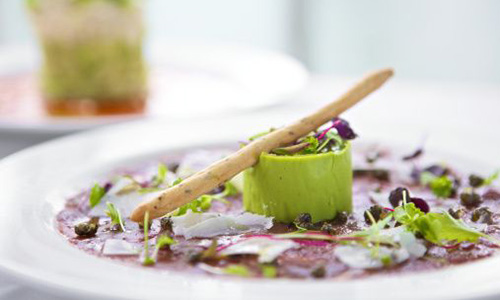
Ingredients for 4 servings:
- 2 beetroots (approx. 200 g each)
- Salt
- 4-5 gelatine sheets or 7g powdered gelatine. (Please follow package instructions.)
- 1 bunch of chives
- 15 g butter
- 150 g frozen peas
- 150 ml broth (instant)
- Freshly ground pepper
- 100 g cream
- 300 g beef tenderloin (have it cut into very thin slices by a butcher)
- 4 tbsp freshly pressed lemon juice
- 6 tbsp olive oil
- 1 tbsp small capers
- 40 g Parmesan
- 2 trays of cress (e.g.: Sakura and Daikon cress)
Preparation:
- Cook beetroots in boiling salt water for 40-45 minutes, drain and let cool in cold water.
- In the meantime, soak gelatine in cold water. Wash chives, shake dry and slice into small rounds.
- Melt butter, sauté chives and peas in the butter. Add broth, season with salt and pepper and let simmer for approx. 5 minutes. Add cream, bringing mixture briefly to a boil, purée and season again.
- Squeeze out gelatine, dissolve in purée. Pour purée into small moulds that have been rinsed with cold water. Refrigerate for approx. 3 hours. Remove from moulds before serving.
- In the meantime, clean and peel, then shred or cut beetroot into thin slices. Wash meat slices, pat dry and flatten them one by one between 2 freezer bags until wafer-thin.
- Layer meat and beetroot on plates, placing the green pea-chive jelly in the centre. Mix together lemon juice, olive oil and capers, season with salt and pepper.
- Garnish carpaccio with shavings of Parmesan and serve sprinkled with a colourful mix of cress.
Goes well with herbed grissini.
Nutritional values per person approx.:
- Calories: 442
- Joules: 1853
- Protein: 26.4 g
- Fat: 30.8 g
- Carbohydrates: 14.8 g
Beetroot – the super tuber for good health
This beet variety has been known for millennia, and not only for its flavour, but also for its many wholesome ingredients. Hippocrates already recommended the external as well as internal use of this healthy winter vegetable. Thus it was also the Romans who brought the beetroot from North Africa to Central Europe, where it became an indispensable part of many well-known dishes such as labskaus, beetroot carpaccio or borscht, an eastern European dish.
Provitamin A, various B vitamins, vitamin C, folic acid, iron, potassium, calcium, magnesium – the list of the nutrients it contains is long. It is especially high in folic acid: just 200 grams of beetroot meet the daily requirement for folic acid, a substance that is not only important for expectant mothers. Its rich red colour comes from the phytochemical betanin, which was an important dye in the Middle Ages and is still in use today as a food dye. Supposedly, beetroot can also raise the serotonin level and thus lighten moods – and that in addition to the many other positive effects it has on the blood, blood vessels, wound healing, heart, gall bladder, liver and skin. It keeps us from coming down with colds, protects us from free radicals and promotes detoxification. As it contains hardly any fats, it can play a valuable role in dieting and as a juice for fasting cures.
You can eat the tuber raw or cooked. When preparing beetroot, it is best to add a few splashes of lemon juice; the vitamin C prevents the formation of nitrosamine, a toxic substance. Moreover, make sure to only reheat beetroot once. A very savoury combination is beetroot with sheep or goat cheese as well as crème fraîche.
Tip: not only the root vegetable itself, but also the leaves of the beetroot are an extremely wholesome delicacy. Carefully cooked, their flavour is reminiscent of Swiss chard, a close relative of the beetroot. The leaves contain even more nutrients than the tuber itself.